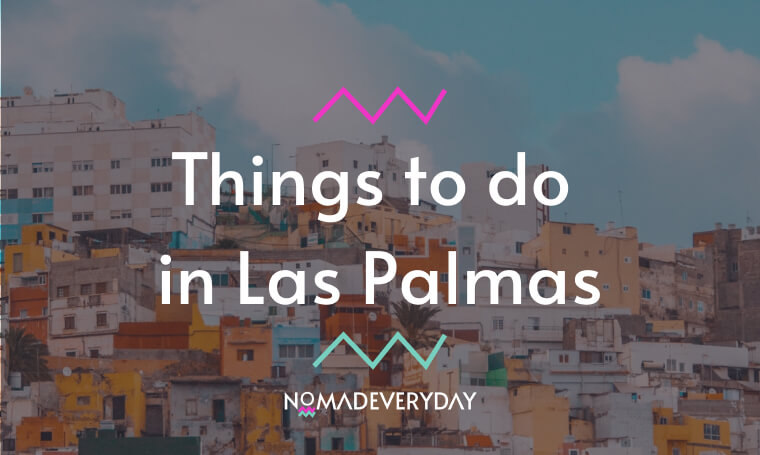So you’ve just landed in Gran Canaria and are looking for things to do in Las Palmas, Gran Canaria? We’ve got you covered!
Located in the northeast of the island, Las Palmas is the capital and the most populated city of the island.
Parks, beautiful landscapes, museums, and a great climate: Las Palmas is one of the must-see cities in the Canary Islands for many reasons.
With great recreational and cultural activities, Las Palmas is an ideal destination to spend a vacation at any time of the year.
Its average annual temperature is about 22 ° C, without exceeding 25 ° C during the summer months.
It is a large city where, in addition to its beaches, you will find large areas for walking, as well as enjoy cultural and leisure activities.
And no matter what activity you choose, from walks to sea excursions to city experiences, you are sure not to be disappointed: the Canary Islands are among the most beautiful islands in Spain in terms of landscape variety.
You might also like:
Top 8 things to do in Las Palmas during your stay in Grand Canaria
Playa de la Canteras
Canteras beach is a beautiful beach, which makes the Canary Islands proud, it is located on the island of Gran Canaria, just outside Las Palmas.
This is the city’s main beach, with more than three kilometers of beachfront.
It is an urban beach, 4 km long, with white and black sand areas, and a natural barrier against wind and waves, which makes it pleasant at any time of the year.
In its transparent waters you can see fish. The tide is often so calm that you will feel like you are swimming in a pool.
La playa de la Canteras is a meeting place, where people come to walk along the beach, play, do sports, and party.
At several points, there are showers, toilets, and lifeguards. The ends are less guarded and have fewer services, but also less crowded on busy days.
There are dozens of bars and restaurants, tapas bars, pizzerias, and grilled fish restaurants.
The beach is clean for being a city beach, Las Palmas has 380,000 inhabitants, but thanks to its orientation, the beach receives clean water from the ocean.
It is an unmissable things to do in Las Palmas however, the most beautiful beaches of the island are however in the south.
Stroll around the old district of Triana et Vegueta
Visit the Vegueta and Triana areas in Las Palmas, which are the city’s oldest neighborhoods.
They are the city of Las Palmas’ oldest neighborhoods.
The small alleyways and aristocratic palaces of La Vegueta will transport you back to the medieval era, with styles ranging from the 18th to the 20th centuries.
The explanation for this is simple: numerous merchant families from the main street, including Spanish, Danish, Maltese, and English, have established here.
This was Las Palmas’ original core. The Plaza de San Antonio Abad is the city’s major square.
The mansion of Christopher Columbus (Casa de Colón) can also be seen. It is a museum dedicated to the famous explorer, not a residence.
The current location has four historical residences dating from the 16th to the 18th centuries, including the original governor’s residence, which Christopher Columbus visited.
Another interesting fact is that one of these houses was formerly the home of the legendary tenor Alfredo Kraus, to whom the auditorium we’ll discuss later was dedicated.
Cathedral of Las Palmas de Gran Canaria
The Vegueta neighborhood is comprised of many tiny, cobblestone alleyways lined with houses that are typical of Canarian architecture.
Go to the Santa Ana square and go through the streets of Balcones or Espiritu Santo to locate another treasure: the Santa Ana cathedral.
It was the first structure built by Spanish royalty after Gran Canaria was conquered in 1478.
The styles vary, ranging from neoclassical to gothic to Renaissance.
The construction began in 1500 and was not completed for another four centuries, despite the involvement of numerous architects and painters.
The artist José Lujan Pérez has multiple works and many statues in the cathedral chapel.
Casa de Colón Congress Palace
In the historic heart of Las Palmas de Gran Canaria, in the north of the island, stands a beautiful colonial-style building known as Casa de Colón.
Open to the public every day, this house offers thirteen exhibition rooms dedicated to the history of the Canary Islands and their relationship with America.
It is the perfect place to learn more about the Canary and American cultures before the arrival of the Europeans, but it also allows you to discover how these adventurers of the sea lived.
This building belonged to the first governors of Gran Canaria and was used as lodging by Christopher Columbus when he stopped over in the Canary Islands at the beginning of his voyages to America.
The beauty of this building and its patios have made it a sight not to be missed during a trip to Las Palmas de Gran Canaria, as well as an iconic figure in the historic heart of Vegueta.
Shopping and Tapas
The Mayor de Triana street and its neighbouring streets, surrounded with many modernist buildings, are then one of the city’s main commercial centers.
There are a variety of shops here, including handicrafts and designer labels.
There are also numerous terraces where you may enjoy tapas or even lunch.
Papas arrugadas con mojo (skinless potatoes with a spicy sauce) and sancocho are two of the most exquisite Canarian dishes (a fish and potato dish).
You will not be disappointed if you choose one of the restaurants around Hurtado de Mendoza and Cairasco squares.
Visit Castillo de La Luz
The Castillo de la Luz, built in 1494 and located on the southern coast of La Isleta, has defended Las Palmas de Gran Canaria’s natural harbor for centuries.
It was built to keep the island safe from pirate raids and invasions.
It is a sturdy square castle with a platform for 11 guns that dates back to the time of the Castilian invasion.
Despite this, it was severely damaged during the Dutch pirate attack in 1599.
The Castillo de la Luz was designated as a national historic monument in 1941.
The stronghold was renovated in 1998 and currently serves as a cultural and exposition center that holds national and international events.
Museo Canario
The Museo Canario, located near the cathedral, was founded in 1879 and is the island’s principal museum.
The Museo Canario in Las Palmas de Gran Canaria, the archipelago’s capital, features a massive collection on the archipelago’s history that spans eleven rooms.
It traces Gran Canaria’s history prior to the invasion.
Any visitor with questions regarding the history of the Canary Islands can inquire about the archaeological discoveries made on the island throughout the years.
It also houses one of the most photographed collections of mummies and aboriginal skeletons: admiring the displays gives the feeling of being transported to the workplace of an ancient scientist.
Alfredo Kraus Auditorium
It is a contemporary edifice designed by Oscar Tusquets and dedicated to tenor Alfredo Kraus of the Canary Islands.
The venue was created to host concerts, gatherings, conventions, and seminars.
After almost 4 years of construction, the project to build a form of lighthouse to defend the coastline of Las Canteras finally opened on December 5, 1997.
Concerts, both classical and modern, are held frequently in two halls. A stained glass window viewing the ocean can be found in the main one.
The Canary Islands Music Festival attracts some of the world’s most prestigious orchestras and performers at the start of each year.
The Auditorium hosts its own concert series throughout the year.
The Auditorium hosts its own concert series as well as those of the Las Palmas Philharmonic Orchestra and the annual Jazz and Guitar Festival throughout the year, totaling around 100 concerts of various genres.
Pérez Galdós Theater
The Pérez Galdós Theater, located in the southeast of the Vegueta district, is one of Las Palmas’ most iconic structures.
It is the permanent home of the Alfredo Kraus Opera Festival of Las Palmas de Gran Canaria, which was founded in 1919 by local architect Manuel Martn Fernandez de la Torre.
It is now one of Spain’s most sophisticated theaters, having undergone a comprehensive makeover in 2007.
Inside, admire the frescoes painted by the architect’s brother, the famed painter Néstor de la Torre, and the tropical exuberance of the Saint-Sans room on the second story.
Is Las Palmas worth visiting?
We would recommend to visit Las Palmas for 1 day. It’s surrounding are worth seeing.
What is Las Palmas known for?
The lively city is world famous for its festivals such as the carnival weeks in February. In Las Palmas you can also enjoy the film festival and the Canarian music festival.
Is Las Palmas safe?
Las Palmas is totally safe. The criminality rate is low is that city however like any big cities we would always recommend you to avoid the dark streets
What is the difference between La Palma and Las Palmas?
Las Palmas is the capital of the island Gran Canaria whereas La Palma is one of the 7 islands of the canaria islands.
Articles you might like:










